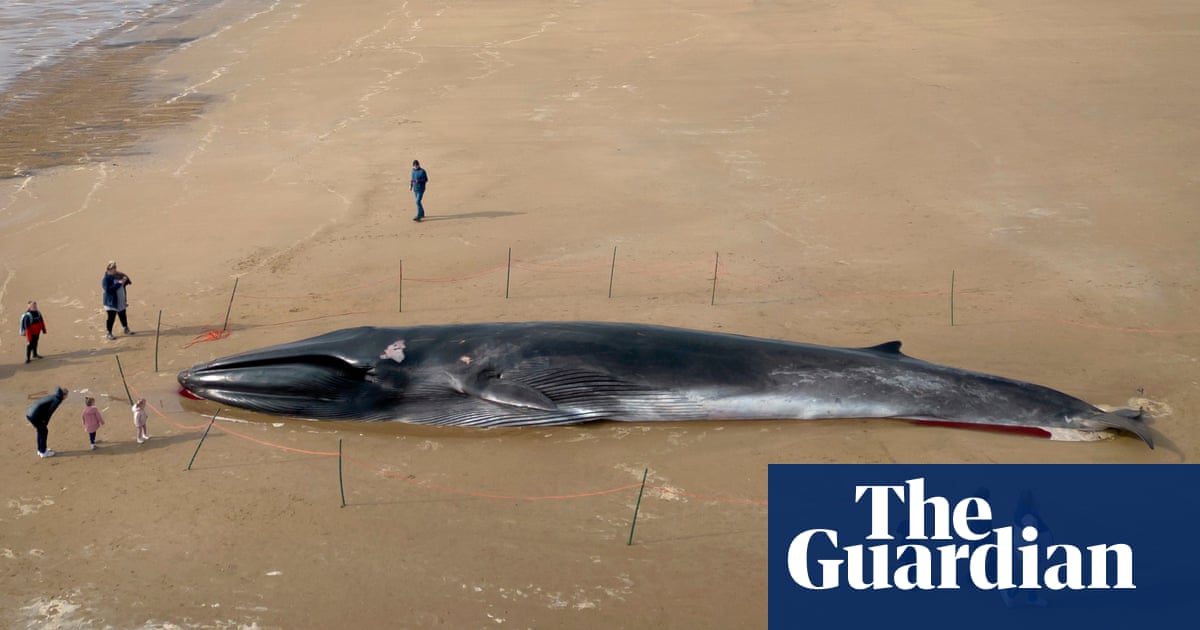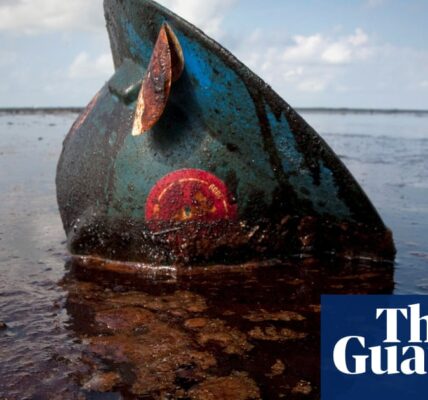
A
After a deceased fin whale was discovered on a Newquay, Cornwall beach this week, specialists are currently faced with a logistical obstacle: how can they dispose of a carcass that weighs multiple tons? Additionally, what actions should be taken if the carcass were to explode?
Every year, a large number of whales get stuck on the shores of Britain, and the frequency of these incidents is increasing. Since its establishment in 1990, the Cetacean Strandings Investigation Programme (CSIP) by the Zoological Society of London has documented 17,850 cases of stranded cetaceans in the UK. This year, there has been a significant increase in whale strandings, such as the recent event in July where 55 pilot whales were found stranded on the Isle of Lewis in Scotland, marking one of the UK’s largest mass strandings to date.
“In my 25 years of working here, we used to see around 500 to 600 strandings per year, but now we are seeing 1,000,” stated Rob Deaville, the project manager for CSIP. He was among the team of experts who performed postmortem examinations on the mass stranding in July.
Finding a beached whale presents numerous challenges for the nearby governments and groups responsible for removing the dead body.
According to Danny Groves from the cetacean charity WDC, when a whale washes up on shore, it can decompose quickly and pose a public health concern. The presence of bacteria can be dangerous, so it is advised for both people and pets to avoid the area. In many cases, the beach is disinfected after the whale is removed.
The challenges of relocating a deceased whale, which can range from 1 to 40 tonnes in weight, are amplified by the risk of the decaying carcass becoming explosive.
As stated by Groves, they have the potential to explode if left alone due to the accumulation of gases within their bodies in certain situations.
In 2019, a video was uploaded on Youtube showcasing the shocking and unexpected release of methane gas from a decomposing whale carcass in the waters near Tomales Bay, California. A separate video recorded the loud noises caused by two sperm whale explosions on the shores of Ameland island in the Netherlands in 1997.
The swelling phase of a whale’s decay is a major concern when they wash up on popular beaches, and organizations must act quickly to protect the safety of the public.
In July, a 50-ton fin whale was discovered on the coast of Kerry in Ireland. Due to its difficult placement, local officials were unable to move the carcass and chose to let it decompose in its original location, despite the potential dangers of gas buildup.
Different techniques have been employed by organizations globally to address the issue of large carcasses and their potential hazard to safety, with varying levels of effectiveness.
In 1970, video footage captured the extreme attempt of American engineers to employ C-4 plastic explosives attached to a dead whale in order to break it down in a controlled manner, hoping that scavengers would then consume the remains.
The video shows why local councils discourage using explosives to get rid of whale carcasses. The detonation caused strong odors of decaying whale to spread throughout the area and sent large pieces of whale flesh flying, damaging vehicles that were parked 400 meters away.
Recently, there have been other instances of using explosives on the bodies of whales, with comparable outcomes. In 2005, the Icelandic coastguard attempted to remove a whale carcass from Hafnarfjörður harbour by using explosives to divide it into two pieces and then manually pulling both pieces out to sea. Unfortunately, this plan failed as both pieces quickly returned to shore.
Skip over the advertisement for the newsletter.
after newsletter promotion
In May 2023, authorities were concerned about the possibility of a large dead whale exploding and scattering decaying body parts on the beach. They took precautions by closing off the area around the 30 tonne beached whale on the East Yorkshire coast. Although it drew curious visitors, the carcass was also a hazard and was ultimately removed in one piece by officials.
Disposing of carcasses in landfills is typically considered the most efficient method, with approximately one-third of beached whales in the US being disposed of this way.
Difficult situations arise when whales get stuck on private property, as the landowners may struggle with the expenses of removing the carcass.
Deaville stated that the most significant and costly removal on our turf was possibly a fin whale in Cornwall, which could have amounted to £20,000-£30,000. The retrieval process was quite intricate, as it required assistance from the police and low loaders to transport it through narrow roads to a rendering facility.
The process of rendering, which is becoming more popular in the UK, includes breaking down parts of cetacean carcasses, boiling them, and mixing them with alcohol to produce biodiesel.
Burning has also been utilized as a secure method of disposing of remains, although it may present challenges when dealing with a large carcass.
Deaville stated that while it is not as commonly used nowadays, it remains a viable option. When there is a high number of animal deaths in a given area, they must be disposed of, usually through cremation. However, there is a challenge when it comes to larger animals, like whales, as the cremation equipment may not be big enough to accommodate them. In such cases, the animal must be dismembered in order to fit into the equipment.
Source: theguardian.com


